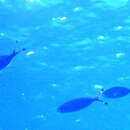fr
noms dans le fil d’Ariane


Caesio suevica , the Suez fusilier, is a species of marine ray-finned fish, a fusilier belonging to the family Caesionidae. It is endemic to the Red Sea.
Caesio suevica was first formally described in 1884 by the German zoologist Carl Benjamin Klunzinger with the type locality given as El Qoseir on the Red Sea coast of Egypt.[2] In his 1987 review of the genus Caesio, Kent E. Carpenter placed this species in the subgenus Flavicaesio.[3] The specific name means “belonging to Suez”, the Gulf of Suez being just to the north of the type locality.[4]
Caesio suevica has a moderately slender, fusiform and laterally compressed body. The jaws, vomer and palatines have small conical teeth.[3] The dorsal fin has 10 spines and 14-15 soft rays while the anal fin has 3 spines and 12 soft rays. This species can reach a maximum total length of 35 cm (14 in). These fishes are light silver blue, with fine gray stripes. The back shows a yellow line starting at the base of the dorsal fin. Ventrally they are paler. The tip of each caudal-fin lobe has a black blotch bordered by a white band.[5]
Caesio suevica is endemic to the Red Sea records from elsewhere in the Indian Ocean are probably misidentifications.[1] The Suez fusilier inhabits coastal areas, especially on coral reefs, at a depth from 2 to 25 m.[5]
Caesio suevica form large midwater aggregations. They are oviparous. Females lay many, small pelagic eggs. They mainly feed on zooplankton,[5] mostly ctenophores and scyphozoans.[1]
Caesio suevica is sometimes fished for using handlines and gill nets. It is not a frequent target species for fisheries although, in Jordan, it is a commercially important.[1]
Caesio suevica , the Suez fusilier, is a species of marine ray-finned fish, a fusilier belonging to the family Caesionidae. It is endemic to the Red Sea.
Caesio suevica Caesio generoko animalia da. Arrainen barruko Actinopterygii klasean sailkatzen da, Caesionidae familian.
Caesio suevica Caesio generoko animalia da. Arrainen barruko Actinopterygii klasean sailkatzen da, Caesionidae familian.
De rodezeefuselier (Caesio suevica) is een straalvinnige vis uit de familie van Caesionidae, orde baarsachtigen (Perciformes), die voorkomt in het westen van de Indische Oceaan.
Caesio suevica kan een maximale lengte bereiken van 35 cm. Van de zijkant gezien heeft het lichaam van de vis een normale vorm, van bovenaf gezien is de vorm het best te typeren als gedrongen. De kop is min of meer recht. De ogen zijn normaal van vorm en zijn symmetrisch.
De vis heeft één zijlijn, één rugvin en één aarsvin. Er zijn 10 stekels en 14 tot 15 vinstralen in de rugvin en 3 stekels en 12 vinstralen in de aarsvin.
Caesio suevica is een zoutwatervis die voorkomt in een tropisch klimaat. De soort is voornamelijk te vinden in zeeën en koraalriffen. De diepte waarop de soort voorkomt is 2 tot 25 m onder het wateroppervlak.
Het dieet van de vis bestaat hoofdzakelijk uit dierlijk voedsel, waarmee het zich voedt door selectief plankton uit het water te filteren.
De soort komt niet voor op de Rode Lijst van de IUCN.
De rodezeefuselier (Caesio suevica) is een straalvinnige vis uit de familie van Caesionidae, orde baarsachtigen (Perciformes), die voorkomt in het westen van de Indische Oceaan.